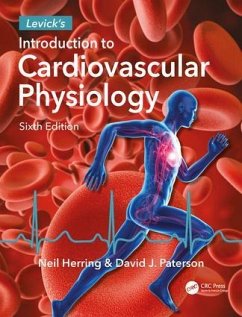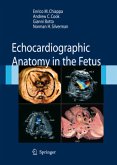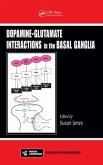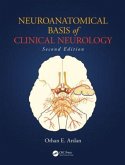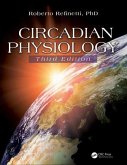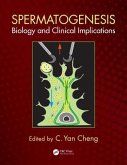- Gebundenes Buch
- Merkliste
- Auf die Merkliste
- Bewerten Bewerten
- Teilen
- Produkt teilen
- Produkterinnerung
- Produkterinnerung
This book provides an accessible introduction to how the cardiovascular system works in health and disease, offering information needed by students and medical examination candidates in a clear, logical, and well-illustrated manner, with many useful line diagrams and tables that support the text and provide proof of concept.
Andere Kunden interessierten sich auch für
![The Heart of Leonardo The Heart of Leonardo]() Francis WellsThe Heart of Leonardo127,99 €
Francis WellsThe Heart of Leonardo127,99 €![Echocardiographic Anatomy in the Fetus Echocardiographic Anatomy in the Fetus]() Enrico ChiappaEchocardiographic Anatomy in the Fetus164,99 €
Enrico ChiappaEchocardiographic Anatomy in the Fetus164,99 €![Dopamine - Glutamate Interactions in the Basal Ganglia Dopamine - Glutamate Interactions in the Basal Ganglia]() Dopamine - Glutamate Interactions in the Basal Ganglia238,99 €
Dopamine - Glutamate Interactions in the Basal Ganglia238,99 €![Neuroanatomical Basis of Clinical Neurology Neuroanatomical Basis of Clinical Neurology]() Orhan E ArslanNeuroanatomical Basis of Clinical Neurology112,99 €
Orhan E ArslanNeuroanatomical Basis of Clinical Neurology112,99 €![Fetal and Perinatal Skeletal Dysplasias Fetal and Perinatal Skeletal Dysplasias]() Christine M HallFetal and Perinatal Skeletal Dysplasias242,99 €
Christine M HallFetal and Perinatal Skeletal Dysplasias242,99 €![Circadian Physiology Circadian Physiology]() Roberto RefinettiCircadian Physiology233,99 €
Roberto RefinettiCircadian Physiology233,99 €![Spermatogenesis Spermatogenesis]() Spermatogenesis223,99 €
Spermatogenesis223,99 €-
-
-
This book provides an accessible introduction to how the cardiovascular system works in health and disease, offering information needed by students and medical examination candidates in a clear, logical, and well-illustrated manner, with many useful line diagrams and tables that support the text and provide proof of concept.
Produktdetails
- Produktdetails
- Verlag: CRC Press
- 6th edition
- Seitenzahl: 426
- Erscheinungstermin: 10. April 2018
- Englisch
- Abmessung: 284mm x 222mm x 32mm
- Gewicht: 1459g
- ISBN-13: 9780815363613
- ISBN-10: 0815363613
- Artikelnr.: 51785488
- Herstellerkennzeichnung
- Libri GmbH
- Europaallee 1
- 36244 Bad Hersfeld
- gpsr@libri.de
- Verlag: CRC Press
- 6th edition
- Seitenzahl: 426
- Erscheinungstermin: 10. April 2018
- Englisch
- Abmessung: 284mm x 222mm x 32mm
- Gewicht: 1459g
- ISBN-13: 9780815363613
- ISBN-10: 0815363613
- Artikelnr.: 51785488
- Herstellerkennzeichnung
- Libri GmbH
- Europaallee 1
- 36244 Bad Hersfeld
- gpsr@libri.de
Neil Herring completed his PhD and medical degree both from the University of Oxford. He is an Associate Professor at the University of Oxford, Consultant Cardiologist at the John Radcliffe Hospital, and Tutor and Fellow of Keble College, Oxford. He has published over 60 peer reviewed original research articles and reviews, and is co-author of the textbooks "Basic Science for Core Medical Training" (highly commended at the BMA Book Awards 2016) and "Levick's Introduction to Cardiovascular Physiology". David J. Paterson is Professor of Physiology and Head of the Department of Physiology, Anatomy & Genetics at the University of Oxford, and a Fellow of Merton College, Oxford. He graduated from the Universities of Otago (NZ), Western Australia and Oxford, gaining his D.Phil from Oxford and D.Sc from the University of Western Australia. He is a group leader in the British Heart Foundation Centre of Research Excellence at Oxford, and is Honorary Director of the Burdon Sanderson Cardiac Science Centre in his Department. As a cardiac neurobiologist, his research focuses on the neural control of the cardiovascular system in normal and diseased states. In 2014 he was made an Honorary Fellow of The Royal Society of New Zealand, and in 2018 was awarded the Carl Ludwig Distinguished Lectureship from the American Physiological Society. He was recently Editor-in-Chief of The Journal of Physiology, and is a Fellow of The Physiological Society, Royal Society of Medicine, and Royal Society of Biology.
Overview of the Cardiovascular System. The Cardiac Cycle. The Cardiac
Myocyte: Excitation and Contraction. Initiation and Nervous Control of
Heartbeat. Electrocardiography and Arrhythmias. Control of Stroke Volume
and Cardiac Output. Assessment of Cardiac Output and Peripheral Pulse.
Hemodynamics: Flow, Pressure and Resistance. The Endothelial Cell. The
Microcirculation and Solute Exchange. Circulation of Fluid Between Plasma,
Interstitium and Lymph. Vascular Smooth Muscle: Excitation, Contraction and
Relaxation. Control of Blood Vessels I. Intrinsic Control. Control of Blood
Vessels II. Extrinsic Control By Nerves and Hormones. Specialization in
Individual Circulations. Cardiovascular Receptors, Reflexes and Central
Control. Coordinated Cardiovascular Responses. Cardiovascular Responses in
Pathological Situations. Future Therapies.
Myocyte: Excitation and Contraction. Initiation and Nervous Control of
Heartbeat. Electrocardiography and Arrhythmias. Control of Stroke Volume
and Cardiac Output. Assessment of Cardiac Output and Peripheral Pulse.
Hemodynamics: Flow, Pressure and Resistance. The Endothelial Cell. The
Microcirculation and Solute Exchange. Circulation of Fluid Between Plasma,
Interstitium and Lymph. Vascular Smooth Muscle: Excitation, Contraction and
Relaxation. Control of Blood Vessels I. Intrinsic Control. Control of Blood
Vessels II. Extrinsic Control By Nerves and Hormones. Specialization in
Individual Circulations. Cardiovascular Receptors, Reflexes and Central
Control. Coordinated Cardiovascular Responses. Cardiovascular Responses in
Pathological Situations. Future Therapies.
Overview of the Cardiovascular System. The Cardiac Cycle. The Cardiac
Myocyte: Excitation and Contraction. Initiation and Nervous Control of
Heartbeat. Electrocardiography and Arrhythmias. Control of Stroke Volume
and Cardiac Output. Assessment of Cardiac Output and Peripheral Pulse.
Hemodynamics: Flow, Pressure and Resistance. The Endothelial Cell. The
Microcirculation and Solute Exchange. Circulation of Fluid Between Plasma,
Interstitium and Lymph. Vascular Smooth Muscle: Excitation, Contraction and
Relaxation. Control of Blood Vessels I. Intrinsic Control. Control of Blood
Vessels II. Extrinsic Control By Nerves and Hormones. Specialization in
Individual Circulations. Cardiovascular Receptors, Reflexes and Central
Control. Coordinated Cardiovascular Responses. Cardiovascular Responses in
Pathological Situations. Future Therapies.
Myocyte: Excitation and Contraction. Initiation and Nervous Control of
Heartbeat. Electrocardiography and Arrhythmias. Control of Stroke Volume
and Cardiac Output. Assessment of Cardiac Output and Peripheral Pulse.
Hemodynamics: Flow, Pressure and Resistance. The Endothelial Cell. The
Microcirculation and Solute Exchange. Circulation of Fluid Between Plasma,
Interstitium and Lymph. Vascular Smooth Muscle: Excitation, Contraction and
Relaxation. Control of Blood Vessels I. Intrinsic Control. Control of Blood
Vessels II. Extrinsic Control By Nerves and Hormones. Specialization in
Individual Circulations. Cardiovascular Receptors, Reflexes and Central
Control. Coordinated Cardiovascular Responses. Cardiovascular Responses in
Pathological Situations. Future Therapies.

